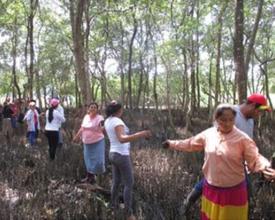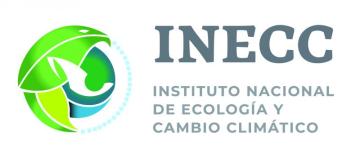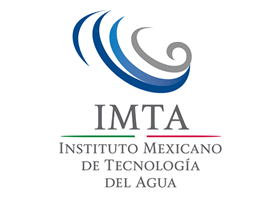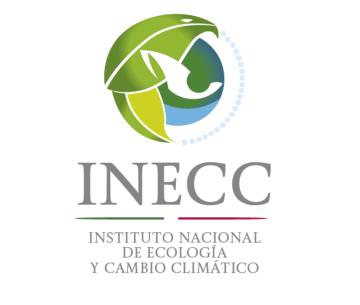
Renforcer les capacités et réduire les risques pour stimuler un processus d'adaptation à long terme
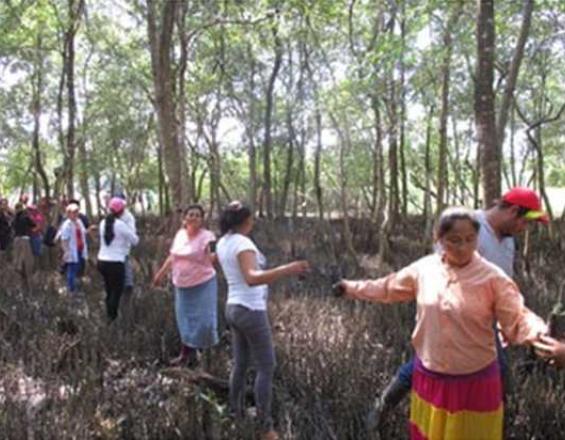
L'Institut national de l'écologie et du changement climatique (INECC) a mis en place un processus participatif et inclusif de sensibilisation aux problèmes socio-environnementaux ainsi que de renforcement des capacités et de réduction des vulnérabilités (par exemple, biens endommagés lors d'inondations, maladies d'origine hydrique, perte de services écosystémiques) dans trois communautés du système lagunaire Carmen-Pajonal-Machona (SLCPM, selon son acronyme espagnol). L'institut a ainsi réussi à jeter les bases d'un processus local d'adaptation à long terme. Ce processus comprend le développement d'une entreprise sociale proposant la capture des eaux de pluie et la purification de l'eau, des activités de reforestation menées par la communauté et la construction d'infrastructures ("palafitos" - maisons sur pilotis) conçues pour réduire les risques pour les biens en cas d'inondation.
Contexte
Défis à relever
- Les ouragans et les tempêtes ne répandent pas seulement la pollution émanant des industries agro-industrielles et pétrolières, ils provoquent la salinisation des sols et de l'eau douce, ainsi que la réduction des stocks de poissons ;
- Le tissu social a été endommagé en raison des différences politiques et/ou religieuses ;
- Il n'y a pas d'organisation, privée ou publique, qui travaille en permanence pour soutenir les communautés ;
- La zone est isolée et peu sûre.
Emplacement
Traiter
Résumé du processus
Le premier bloc, qui vise à encourager la participation des communautés, s'est attaché à attirer l'attention des gens et à les sensibiliser, deux éléments essentiels pour les faire participer aux activités des blocs deux (reboisement de la mangrove), trois (les femmes en tant qu'agents du changement) et quatre (gestion des risques). Le bloc trois a offert aux femmes un espace où elles ont pu faire part de leurs besoins particuliers et de leurs vulnérabilités. Il a également renforcé l'image qu'elles ont d'elles-mêmes, ce qui les a incitées à participer davantage aux activités des autres modules. Le cinquième pilier consiste en diverses formes de soutien institutionnel et organisationnel tout au long des quatre premiers piliers et de leurs activités sur le terrain.
Blocs de construction
Encourager la participation de la communauté comme moteur de transformation
L'INECC reconnaît que l'adaptation doit se faire "avec les gens, pour les gens". Il a été essentiel d'encourager la participation des communautés au sein de la zone afin de mener à bien toute action visant à restaurer, gérer et conserver les mangroves locales. Avec le soutien d'organisations locales, l'INECC a créé, pour les communautés locales, des espaces d'apprentissage social, d'interaction et de communication. Ces espaces ont facilité la diffusion d'informations sur le rôle important des écosystèmes dans les moyens de subsistance locaux, la sensibilisation aux menaces qui pèsent sur les systèmes socio-écologiques dans lesquels les communautés prospèrent et le développement des capacités en matière de gestion durable des ressources et de commercialisation des services écosystémiques. Le travail constant et cohérent des organisations locales avec les communautés a créé un sentiment d'appartenance à l'égard de leur écosystème et une responsabilité dans les décisions et les actions visant à en prendre soin.
Facteurs favorables
- Une vision communautaire bien développée, dès le départ, de ce que le changement climatique signifie pour leurs moyens de subsistance et l'écosystème dans lequel ils vivent, ainsi que des problèmes quotidiens auxquels ils sont confrontés.
- Un soutien engagé et cohérent de la part d'ONG locales expérimentées
- des institutions crédibles
- La confiance des communautés en elles-mêmes et dans les ONG
Leçon apprise
- Il est essentiel d'écouter la communauté et de lui donner la possibilité de s'exprimer et de participer à long terme.
- Les membres de la communauté doivent maintenir un niveau élevé d'engagement envers le projet lorsqu'il passe du diagnostic à l'action concrète sur le terrain.
- Cet engagement sera stimulé par la reconnaissance externe de leurs activités.
Reboisement de la mangrove financé par le projet et soutenu par la communauté
Tirant le meilleur parti des fonds du projet, l'INECC, en collaboration avec des ONG locales, a lancé des activités de reboisement et d'entretien des mangroves. La stratégie consistait à travailler avec les communautés pour les sensibiliser davantage à l'importance d'une mangrove saine pour leurs moyens de subsistance. En outre, des ateliers ont été organisés avec des enfants, des femmes et des hommes pour leur permettre de participer à la prise de décision concernant les activités liées à la mangrove. Ainsi, les membres de la communauté se sont appropriés ces activités, les considérant comme bénéfiques pour leurs activités productives et pour le bien-être général de leurs familles. En fin de compte, ce sont les membres de la communauté qui ont décidé où reboiser et avec quelles espèces locales. Bien que le reboisement n'ait pas réussi en raison de problèmes techniques, saisonniers et administratifs qui ont fait qu'une grande partie des semis n'a pas survécu, l'activité communautaire a joué un rôle clé dans la confiance accordée à l'INECC. Cela a stimulé le capital social pour soutenir d'autres processus sociaux, prévus dans le projet plus large, tels que la construction de "palafitos", le système de captage des eaux de pluie, etc.
Facteurs favorables
- Des ressources humaines et économiques, afin de faciliter l'emploi des communautés locales dans les activités de reboisement.
- Soutien engagé et constant de la part d'ONG locales expérimentées
- Des membres de la communauté qui maintiennent un niveau élevé d'engagement envers le projet lorsqu'il passe du diagnostic à l'action concrète sur le terrain.
- Les ateliers visant à susciter une réflexion au sein de la communauté sur les activités de reboisement ont créé un sentiment de responsabilité à l'égard des activités entreprises.
Leçon apprise
- Il convient d'envisager l'utilisation des techniques de "chinampas" (monticules de boue servant de support aux semis) pour le reboisement des mangroves de basse altitude.
- Pour les activités saisonnières telles que la plantation de mangroves, il est essentiel de s'assurer que le financement est mis en place au moment où il est nécessaire, c'est-à-dire au moment où les semis prospéreront le mieux.
- La participation de la communauté doit être complétée par des connaissances scientifiques sur la manière, le type et le moment de planter des espèces particulières.
- Des réseaux de financement multiples sont nécessaires pour s'assurer que le financement est disponible au moment où il est nécessaire afin d'assurer la continuité du projet et de ne pas perdre l'élan de la communauté.
Positionner les groupes de femmes en tant qu'agents de changement
L'adoption d'une approche axée sur l'égalité des sexes dans le projet a permis de prendre en compte les perceptions et les préoccupations des femmes. Dans les ateliers réservés aux femmes, leur vulnérabilité sociale sous la forme de violence familiale, de criminalité et de toxicomanie a été reconnue. En outre, les ateliers ont mis en évidence leur désir de participer aux activités du projet qui permettraient d'améliorer la qualité de vie de leurs familles. Leur participation a été multiple. Par exemple, afin de garantir l'accès à l'eau potable, le groupe de femmes de la communauté de Las Coloradas a été formé à la technologie nécessaire au fonctionnement des systèmes de récupération des eaux de pluie et des équipements de purification de l'eau. En outre, les femmes ont créé l'entreprise sociale "Drops of Love", qui leur permet de fournir de l'eau potable à l'école primaire et à la crèche, tout en vendant le reste de l'eau aux familles de la communauté.
Autre exemple, après avoir acquis des compétences en construction et en écotechnologie, les femmes de la communauté d'El Mingo ont formé le groupe "La brise d'El Mingo" afin de participer à la construction de palafitos destinés à protéger, en cas de catastrophe, les biens et les propriétés des 80 familles de la communauté.
Facteurs favorables
- La capacité d'identifier dès le début du projet les besoins, les vulnérabilités et les capacités des femmes locales, et donc de bien les intégrer dans la conception des mesures d'adaptation.
- Des ateliers de réflexion sur les mesures d'adaptation qui ont favorisé l'engagement continu des femmes à participer au projet
- un esprit de fierté et d'entreprise croissant de la part des femmes des communautés
- un soutien engagé et cohérent de la part d'ONG locales expérimentées.
Leçon apprise
- Des femmes compétentes et conscientes de la nécessité de s'adapter sont une source d'enthousiasme, de motivation et de dynamisme pour la mise en œuvre efficace de projets qui soutiennent l'amélioration de la vie familiale ;
- L'autonomisation des femmes ne se limite pas à leur participation à des ateliers ; leur encadrement continu, par des facilitateurs locaux, à moyen et long terme, est vital pour la durabilité des projets ;
- La participation des femmes au projet a stimulé leur participation active à des activités au-delà du projet ;
- Dans les communautés où il existe un fossé profond entre les activités entreprises par les hommes et les femmes, traiter l'égalité des sexes uniquement comme une question d'identification des projets féminins peut entraîner le risque que des questions productives importantes en rapport avec les moyens de subsistance de la communauté ne soient pas prises en compte dans les mesures mises en œuvre. Une approche sexospécifique de la planification de l'adaptation communautaire, qui envisage les mesures d'adaptation du point de vue des hommes et des femmes, est une approche efficace pour garantir que les activités des hommes et des femmes sont soutenues par l'adaptation.
Initiatives collectives pour la réduction des risques de catastrophes
La réduction des vulnérabilités et le renforcement des capacités d'adaptation dans le SLCPM ont également impliqué le renforcement de la gestion collective des communautés et la réduction des risques de catastrophes, qu'il s'agisse de maladies ou d'inondations. Par exemple, face aux difficultés d'accès à l'eau potable et aux risques de maladies cutanées et gastro-intestinales qui en découlent, les communautés ont investi dans l'infrastructure et la santé. Il s'agit notamment de l'installation de systèmes de récupération des eaux de pluie ainsi que d'équipements de purification et d'embouteillage de l'eau ; de la création d'une entreprise sociale communautaire "Gouttes d'amour" ("Gotitas de Amor") grâce à laquelle de l'eau potable est produite et fournie à l'école primaire et à la crèche, puis revendue pour augmenter l'approvisionnement en eau potable des familles de la communauté.
En outre, les risques d'inondation pour les biens et les propriétés ont été gérés et réduits grâce à une initiative collective qui comprenait non seulement la construction de palofitos (plates-formes couvertes sur pilotis), mais aussi la création de plans d'urgence et leur promotion par la mise en place d'un comité de protection civile.
Facteurs favorables
- Des ressources financières suffisantes pour pouvoir verser des indemnités journalières aux membres de la communauté afin de les inciter à travailler sur les différentes activités de mise en œuvre du projet ;
- Capacité à prouver aux communautés que les actions identifiées lors des ateliers sont mises en œuvre ;
- Disponibilité d'un terrain de taille suffisante, ainsi que d'une position stratégique, et de préférence propriété de la communauté, pour la construction de palafitos qui peuvent servir de refuges pour les biens de la communauté ;
- Enthousiasme pour une participation active à la mise en œuvre des activités du projet.
Leçon apprise
- La construction de maisons surélevées ("Palafitos") peut constituer une stratégie efficace de gestion et de réduction des risques d'inondation ; toutefois, elle nécessite l'engagement continu de la communauté à entretenir et à utiliser équitablement ces installations dans l'intérêt de tous ;
- Il est important de garder à l'esprit que le changement climatique ne présente pas seulement des risques directs pour les communautés et leurs écosystèmes ; il peut également exacerber les problèmes structurels existants dans les systèmes socio-écologiques dans lesquels elles vivent. La réduction des risques d'inondation, par exemple, devrait également inclure des mesures visant à atténuer ces problèmes, tels que la pollution systémique de l'eau due aux activités d'élevage, de pétrole et de canne à sucre, qui aggrave considérablement les dommages matériels causés par les inondations ;
- Il est important d'avoir des plans concrets pour étendre les projets de démonstration, tels que la construction de Palafitos ;
Construire des alliances stratégiques multi-niveaux et multi-acteurs
L'INECC a établi une alliance multi-acteurs avec des institutions publiques et privées à différents niveaux de gouvernance, du fédéral au local. C'est cette alliance qui a pu faciliter le fonctionnement efficace des quatre autres éléments de cette solution, en particulier grâce à un soutien institutionnel pour le développement des capacités et le suivi par des organisations expérimentées.
Voici quelques exemples de développement des capacités des membres de l'alliance :
- Soutien à l'alphabétisation des communautés - Institut national d'éducation des adultes (INEA), Tabasco
- Don de ciment et de bouteilles - Arji College, Tabasco
- Construction de potagers surélevés pour les écoles et les palafitos - Centro de Información y Comunicación Ambiental de América del Norte (CICEANA)
- Préparation de matériel didactique - Centro de Educación y Capacitación para el Desarrollo Sustentable (CECADESU)
- Conception de cartes de risques et de plans de zone axés sur le changement climatique - Universités et autorités de Tabasco
Facteurs favorables
- Des autorités gouvernementales ouvertes d'esprit ;
- Des ressources suffisantes pour permettre la poursuite des activités de développement des capacités jusqu'au moment où la communauté s'auto-organise.
Leçon apprise
Il est nécessaire de préparer une stratégie de coordination de l'alliance et une communication claire afin que les membres de l'alliance et les membres de la communauté puissent comprendre le rôle des différents membres de l'alliance qui se rendent dans leur zone, savoir ce qu'ils doivent attendre d'eux et comment collaborer avec eux.
Impacts
Les communautés locales ont bénéficié d'un encadrement pendant près de trois ans, assuré par des ONG et le gouvernement local sous les auspices de l'INECC. Cela a permis de développer les capacités dans les domaines suivants
- amélioration des capacités à identifier les menaces, leurs origines et les solutions ;
- capacité d'organisation pour soutenir la réduction des risques, tels que les maladies liées à la consommation d'eau contaminée, ainsi que les inondations ;
- les capacités techniques liées à la mise en place de diverses écotechnologies telles que les systèmes de captage des eaux de pluie, les pépinières et le reboisement des mangroves.
Les groupes de femmes ont particulièrement bénéficié de l'augmentation de leur confiance en soi, ce qui leur a permis de créer des systèmes de gouvernance qui ont renforcé la cohésion sociale dans la région. Les groupes ont également initié des changements qui requièrent un haut niveau d'organisation, tels que l'ouverture de nouvelles voies pour la commercialisation des services écosystémiques au profit de la société.
Bénéficiaires
200 personnes ont reçu des indemnités journalières en échange de leur travail sur des activités d'adaptation ; des groupes de femmes ont été reconnus par leurs communautés. Près de 800 personnes et une école locale ont bénéficié d'un système de récupération et de purification de l'eau de pluie.
Objectifs de développement durable
Histoire
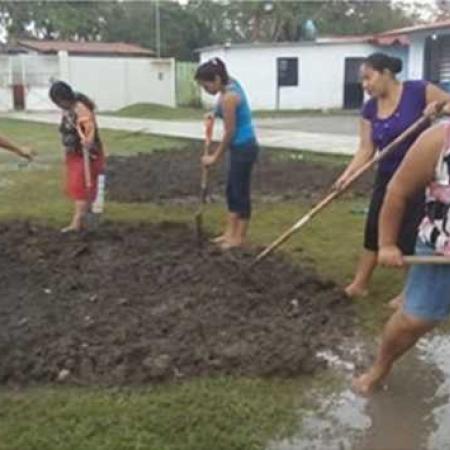
Le système lagunaire Carmen-Pajonal-Machona à Tabasco, au Mexique, est une zone hautement productive qui a été affectée par des travaux d'infrastructure qui ont entraîné la salinisation des masses d'eau et des sols. Elle a également été affectée par la pollution dérivée de l'industrie pétrolière, de l'industrie sucrière et de l'agriculture. Lorsque les menaces liées au changement climatique, telles que les ouragans et les tempêtes tropicales, frappent la région, les écosystèmes et les communautés sont confrontés à des risques en cascade : Les inondations affectent les infrastructures et contribuent à la sédimentation des masses d'eau. Elles propagent également la pollution éventuellement contenue dans les rivières, ce qui nuit à la santé des êtres humains, des animaux et des plantes. Dans la SLCPM, l'eau est le principal problème, qu'il s'agisse du manque d'approvisionnement et de qualité pour les communautés locales ou des inondations récurrentes.
Le projet a débuté par une stratégie participative visant à réduire les vulnérabilités et à renforcer les capacités de trois communautés. Une action clé a consisté à impliquer les communautés à un stade précoce dans la définition du problème et dans la sélection des mesures et des sites d'intervention clés. Un premier mécanisme d'organisation sociale a été mis en place par le biais d'activités de reboisement communautaires qui, bien qu'ayant connu un succès limité, ont servi à stimuler l'implication des populations dans les activités ultérieures du projet. Par exemple, la récupération des eaux de pluie et la construction d'une station d'épuration dans la communauté de Las Coloradas ; la construction de "palafitos" (plates-formes surélevées et couvertes sur pilotis) dans la communauté d'El Mingo pour servir de refuges en cas d'inondation et d'espaces d'expérimentation pour les éco-technologies. Dans les deux cas, ce sont les femmes qui ont été les plus impliquées dans le développement de leurs capacités en termes de technologie, d'organisation et d'administration. Elles étaient également les plus susceptibles d'assurer la continuité des activités du projet.
Le système de captage et de purification des eaux de pluie a bénéficié à près de 800 personnes, fournissant gratuitement une eau de qualité aux élèves d'une école primaire locale. Cela a permis de réduire l'incidence des maladies gastro-intestinales chez les enfants. La construction de "palafitos" par le groupe de femmes "Las Brisas", récemment formé aux techniques de construction, a éveillé l'intérêt d'autres communautés pour la mise en place de leurs propres "palafitos" afin de réduire les risques d'inondation pour les biens.
Le soutien supplémentaire de l'INECC a également porté sur le suivi et l'évaluation des actions d'adaptation mises en œuvre.
